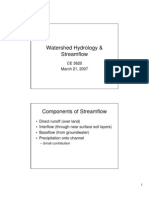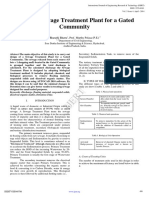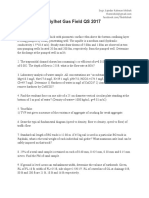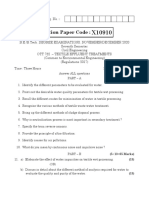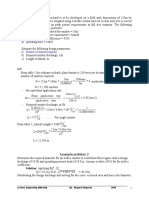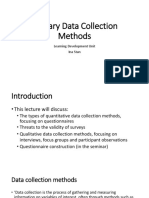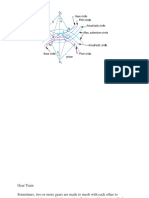Problem 11-4 Instructors Note: This Problem Is Similar To Example 11-2. Head Loss Through Two
Problem 11-4 Instructors Note: This Problem Is Similar To Example 11-2. Head Loss Through Two
Uploaded by
Aljebre MohmedCopyright:
Available Formats
Problem 11-4 Instructors Note: This Problem Is Similar To Example 11-2. Head Loss Through Two
Problem 11-4 Instructors Note: This Problem Is Similar To Example 11-2. Head Loss Through Two
Uploaded by
Aljebre MohmedOriginal Title
Copyright
Available Formats
Share this document
Did you find this document useful?
Is this content inappropriate?
Copyright:
Available Formats
Problem 11-4 Instructors Note: This Problem Is Similar To Example 11-2. Head Loss Through Two
Problem 11-4 Instructors Note: This Problem Is Similar To Example 11-2. Head Loss Through Two
Uploaded by
Aljebre MohmedCopyright:
Available Formats
clean the filter excessively.
Excessively clean media takes longer to ripen and
more water is wasted. Use of a filter aid polymer in the backwash water can also
minimize the duration of ripening.
PROBLEM 11-4
Instructors Note: This problem is similar to Example 11-2. Head loss through two
layers of media are additive. No pilot or site-specific information is given, so midpoint
values are selected from Table 11-3. The solution is solved completely for problem C
and the solution to the remaining problems are listed at the end of the solution.
Problem Statement - A filter is designed with the following specifications. The
anthracite and sand have density of 1,700 and 2,650 kg/m3, respectively, and the
design temperature is 10ºC. For a given sample (A, B, C, D, or E, to be selected
by instructor), calculate the clean bed head loss.
Item A B C D E
Bed type mono- mono- dual- dual- dual-
media media media media media
Filtration rate (m/h) 8 15 15 10 10
Anthracite specifications:
Effective size (mm) 1.0 1.0 1.2 1.6
Depth (m) 1.8 1.5 1.4 1.2
Sand specifications:
Effective size (mm) 0.55 0.5 0.55 0.55
Depth (m) 0.75 0.3 0.4 0.7
Solution
1. Use Eq. 11-13 to calculate the head loss through the anthracite. Select the
permeability coefficients and porosity from Table 11-3, and
the density and dynamic viscosity of water from Appendix C, Table C-1.
κV = 228, κI = 4.4, and ε = 0.50. From Appendix C-1 at 10 °C, ρW = 999.7
kg/m3 and µ = 1.307 x 10-3 kg/m·s.
2. Calculate the first term in Eq. 11-13.
Homework Solution Manual Page 6 of 48
MWH’s Water Treatment: Principles and Design, 3rd ed. Version 1
Chapter 11 - Granular Filtration
(1 − ε)2 µLv
hL,1 = κ V
ε3 ρW gd2
( 228 ) (1 − 0.50 )2 (1.307 × 10-3 kg/ms ) (1.5 m )(15 m/h )
=
( 0.50 ) (999.7 kg/m3 )(9.81 m/s2 ) (1.0 mm ) (10-3 m/mm ) ( 3600 s/h )
3 2 2
= 0.380 m
3. Calculate the second term in Eq. 11-13.
(1 − ε) Lv 2
hL,2 = κI
ε3 gd
( 4.4 ) (1 − 0.50 )(1.5 m )(15 m/h )2
= 0.047 m
( 0.50 ) (9.81 m/s2 ) (1.0 mm ) (10−3 m/mm ) (3600 s/h)
3 2
4. Add the two terms together.
hL,anth = hL,1 + hL,2 = 0.380 m + 0.047 m = 0.427 m.
5. Repeat the calculations for sand, using κV = 112, κI = 2.2, and ε = 0.42 from
Table 11-3, yields:
(112 ) (1 − 0.42 )2 (1.307 × 10-3 kg/ms ) ( 0.3 m )(15 m/h )
hL,1 =
( 0.42 ) (999.7 kg/m3 )(9.81 m/s2 ) (0.5 mm ) (10-3 m/mm ) ( 3600 s/h )
3 2 2
= 0.339 m
( 2.2 ) (1 − 0.42 )( 0.3 m )(15 m/h )2
hL,2 =
( 0.42 ) (9.81 m/s2 ) ( 0.5 mm ) (10−3 m/mm ) ( 3600 s/h )
3 2
= 0.018 m
hL,sand = 0.339 m + 0.018 m = 0.357 m
6. The total clean bed head loss through the filter is the sum of the head loss
through the two medias.
hL = 0.427 m + 0.357 m = 0.78 m
7. The solution to the remaining problems is shown below (all values in meters
of head loss):
Problem Anthracite Anthracite Sand, Sand, Total
term 1 term 2 term 1 term 2 head loss
A 0.374 0.012 0.38
Homework Solution Manual Page 7 of 48
MWH’s Water Treatment: Principles and Design, 3rd ed. Version 1
Chapter 11 - Granular Filtration
B 0.456 0.056 0.51
C 0.380 0.047 0.339 0.018 0.78
D 0.164 0.016 0.249 0.01 0.44
E 0.079 0.010 0.436 0.017 0.54
PROBLEM 11-5
Problem Statement - For the media specification given in Problem 7-2 (C, D, or E, to
be selected by instructor), determine if the two media layers are matched to each
other.
Solution
1. For the given sand size, calculate the matched anthracite size using Eq. 11-
25. For problem C:
0.625 0.625
ρ2 − ρ W 2650 − 1000 kg/m3
=d1 d=
2 0.5 mm = 3
0.85 mm
ρ1 − ρ W 1700 − 1000 kg/m
For problems D and E:
0.625 0.625
ρ2 − ρ W 2650 − 1000 kg/m3
=d1 d=
2 0.55 mm = 3
0.94 mm
ρ1 − ρW 1700 − 1000 kg/m
2. The matched anthracite size would be 0.85 mm for 0.50 mm sand and 0.94
mm for 0.55 mm sand. In each problem, the specified anthracite is
considerably larger than the matched size and the media would not be
considered matched.
PROBLEM 11-6
Problem Statement - A filter contains 0.55-mm sand that has a density of 2650 kg/m3.
Calculate the effective size of 1550 kg/m3 anthracite that would be matched to this
sand.
Solution
Matched media can be calculated using Eq. 11-25.
Homework Solution Manual Page 8 of 48
MWH’s Water Treatment: Principles and Design, 3rd ed. Version 1
Chapter 11 - Granular Filtration
You might also like
- CH 12Document29 pagesCH 12Aljebre MohmedNo ratings yet
- Ch10waste WaterDocument29 pagesCh10waste WaterAljebre Mohmed67% (3)
- Ch10waste WaterDocument29 pagesCh10waste WaterAljebre Mohmed67% (3)
- Ch9waste WaterDocument20 pagesCh9waste WaterAljebre Mohmed100% (1)
- CH 11Document48 pagesCH 11Aljebre MohmedNo ratings yet
- Transpo Compilation HeyDocument52 pagesTranspo Compilation HeyAna Lorraine Dalilis60% (5)
- CH 17Document55 pagesCH 17Aljebre Mohmed67% (3)
- 04-Coagulation & Flocculation, Dec. 07, 2017Document22 pages04-Coagulation & Flocculation, Dec. 07, 2017jantskieNo ratings yet
- CH 16Document19 pagesCH 16Aljebre MohmedNo ratings yet
- Problem 16-1 Problem Statement - A SAC Exchanger Is Employed To Remove Calcium Hardness FromDocument4 pagesProblem 16-1 Problem Statement - A SAC Exchanger Is Employed To Remove Calcium Hardness FromAljebre MohmedNo ratings yet
- Jane Dueber - Module 1 Action GuideDocument14 pagesJane Dueber - Module 1 Action GuideVincent J100% (1)
- Problem 11-4 Instructors Note: This Problem Is Similar To Example 11-2. Head Loss Through TwoDocument13 pagesProblem 11-4 Instructors Note: This Problem Is Similar To Example 11-2. Head Loss Through TwoAljebre MohmedNo ratings yet
- Instructor's Notes: This Problem Is Similar To Example 12-2. The Solution Is WorkedDocument10 pagesInstructor's Notes: This Problem Is Similar To Example 12-2. The Solution Is WorkedAljebre MohmedNo ratings yet
- PROBLEMS - Module 4 - Water Pollution Control by Biological MethodsDocument4 pagesPROBLEMS - Module 4 - Water Pollution Control by Biological MethodsRakesh Bramhachari100% (1)
- Time Area MethodDocument7 pagesTime Area Methodpp hsu100% (3)
- Binder 1Document100 pagesBinder 1HemanthNo ratings yet
- Engineering Chemistry First YearDocument3 pagesEngineering Chemistry First YearTabish AleemNo ratings yet
- Ee IiDocument10 pagesEe IiKrithikaVenkatNo ratings yet
- 3 NSQ FiltrationDocument35 pages3 NSQ FiltrationMashaelNo ratings yet
- Ch. 3 NumericalsDocument29 pagesCh. 3 NumericalsMriduNo ratings yet
- V3i4 Ijertv3is040786 PDFDocument5 pagesV3i4 Ijertv3is040786 PDFsarikagNo ratings yet
- Sylhet Gas Field QS 2017Document2 pagesSylhet Gas Field QS 2017Sajedur Rahman MishukNo ratings yet
- Runway Correction (Num1)Document5 pagesRunway Correction (Num1)nishiNo ratings yet
- Question Paper Code:: Reg. No.Document2 pagesQuestion Paper Code:: Reg. No.RioNo ratings yet
- Water Supply Problems and SolutionsDocument14 pagesWater Supply Problems and SolutionsNobodyNo ratings yet
- PROBLEMS - Module 4 - Water Pollution Control by Biological MethodsDocument4 pagesPROBLEMS - Module 4 - Water Pollution Control by Biological MethodsAke TupeslaNo ratings yet
- Pipe NetworkDocument54 pagesPipe Networknandajntu0% (1)
- Laboratory Manual For Determining Oil and Grease For Raw and Treated EffluentDocument3 pagesLaboratory Manual For Determining Oil and Grease For Raw and Treated EffluentAnas YuzairiNo ratings yet
- CHA CHA: Thickener DesignDocument1 pageCHA CHA: Thickener DesignKumar RajeshNo ratings yet
- Hager 1991Document18 pagesHager 1991yaseen90azizNo ratings yet
- 1) (15 PTS) A 10 Inch Diameter Sanitary Sewer Is Designed Such That ItDocument13 pages1) (15 PTS) A 10 Inch Diameter Sanitary Sewer Is Designed Such That ItZeyad Tareq Al Sarori100% (1)
- BOD ProcedureDocument14 pagesBOD ProcedureSajith Ranatunga100% (1)
- Concrete Mix DesignDocument12 pagesConcrete Mix DesignWilliam ProvidoNo ratings yet
- Screening and Grit RemovalDocument6 pagesScreening and Grit Removalnp27031990No ratings yet
- WasteWater Engineering 1516 Sem 1Document7 pagesWasteWater Engineering 1516 Sem 1Tidus FarronNo ratings yet
- Foc 0 BDocument2 pagesFoc 0 BMahmoudRadi100% (1)
- Ce 2354Document10 pagesCe 2354Suresh Raju0% (1)
- B7 PROJECT REPORT NewDocument21 pagesB7 PROJECT REPORT NewvijayNo ratings yet
- Control 4 DR - GhanemDocument131 pagesControl 4 DR - Ghanemabdulqadir100% (1)
- The Newton Raphson MethodDocument61 pagesThe Newton Raphson MethodAlexander DavidNo ratings yet
- Lime Softening PDFDocument16 pagesLime Softening PDFBiljana TausanovicNo ratings yet
- Chapter 3 - Microwave EquipmentDocument10 pagesChapter 3 - Microwave EquipmentNstm3No ratings yet
- Design of HEDocument35 pagesDesign of HESaurabh SengarNo ratings yet
- UPO-1: Unit Processes and Operations (Physico-Chemical) - Question PapersDocument20 pagesUPO-1: Unit Processes and Operations (Physico-Chemical) - Question PapersDr. Akepati Sivarami Reddy100% (2)
- GATE Chemical Engineering Question PaperDocument57 pagesGATE Chemical Engineering Question PaperAshish Kavaiya100% (1)
- Design of Completely Mixed Activated Sludge SystemDocument3 pagesDesign of Completely Mixed Activated Sludge Systemkirakun20% (1)
- PM8082 - Model Exam Question Papers.Document4 pagesPM8082 - Model Exam Question Papers.PCT HABEEBURRAHMANNo ratings yet
- Exp 3 Ammonia Nitrogen and NitrateDocument3 pagesExp 3 Ammonia Nitrogen and NitrateanaNo ratings yet
- Pavement Design 18Cv825Document4 pagesPavement Design 18Cv825Yashodhar SrbNo ratings yet
- Hydraulics Sniper ReportDocument8 pagesHydraulics Sniper ReportKhumo Ezekiel MoraNo ratings yet
- EV305-311 Test 2 Water N Wastewater EngineeringDocument6 pagesEV305-311 Test 2 Water N Wastewater EngineeringSam KhorNo ratings yet
- Lec-8 (Water Quantity Population Esimation) PDFDocument42 pagesLec-8 (Water Quantity Population Esimation) PDFAbdul WahabNo ratings yet
- Activated Sludge Process Design2Document2 pagesActivated Sludge Process Design2Vipin YadavNo ratings yet
- Module 1.6 Settling and SedimentationDocument37 pagesModule 1.6 Settling and SedimentationLong ENo ratings yet
- OXIDITCHcalcpdfDocument11 pagesOXIDITCHcalcpdfMayette Rose SarrozaNo ratings yet
- Assignment 1Document3 pagesAssignment 1Victor Megong JakiNo ratings yet
- Bod AimDocument3 pagesBod Aimrockingtwo07No ratings yet
- Example Problems: Coagulation and FlocculationDocument13 pagesExample Problems: Coagulation and FlocculationRoshineeNo ratings yet
- Lecture: Water Quality Modelling 577l02pDocument9 pagesLecture: Water Quality Modelling 577l02pHilda IsfanoviNo ratings yet
- Canal DesignDocument12 pagesCanal DesignUsman ShehryarNo ratings yet
- Problem 11-9 Problem Statement - Compare The Clean-Bed Head Loss at 15 ºC Through A Rapid FilterDocument10 pagesProblem 11-9 Problem Statement - Compare The Clean-Bed Head Loss at 15 ºC Through A Rapid FilterAljebre Mohmed0% (1)
- Chapter 3 - Drip IrrigationDocument5 pagesChapter 3 - Drip IrrigationEng Ahmed abdilahi IsmailNo ratings yet
- Lecture 4Document24 pagesLecture 4Muhammad ShehzadNo ratings yet
- Principle of Working of Grit ChamberDocument11 pagesPrinciple of Working of Grit ChamberAhmed Amedi100% (3)
- HW #7Document8 pagesHW #7Jigoku KuroakaNo ratings yet
- Kneader Mixer Lab Report by Group E (SECTION A)Document16 pagesKneader Mixer Lab Report by Group E (SECTION A)Maryam Fatima100% (1)
- PROBLEMS - Module 2 - Air Pollution Removal PDFDocument7 pagesPROBLEMS - Module 2 - Air Pollution Removal PDFankursonicivilNo ratings yet
- Analytical Modeling of Solute Transport in Groundwater: Using Models to Understand the Effect of Natural Processes on Contaminant Fate and TransportFrom EverandAnalytical Modeling of Solute Transport in Groundwater: Using Models to Understand the Effect of Natural Processes on Contaminant Fate and TransportNo ratings yet
- ثرمو 13Document74 pagesثرمو 13Aljebre Mohmed100% (1)
- Schap 22Document16 pagesSchap 22Aljebre MohmedNo ratings yet
- SCH4208201002 Reactor TechnologyDocument6 pagesSCH4208201002 Reactor TechnologyAljebre MohmedNo ratings yet
- Iraq - Iraq Disability Law 2013Document8 pagesIraq - Iraq Disability Law 2013Aljebre MohmedNo ratings yet
- Solution: Part 1Document4 pagesSolution: Part 1Aljebre MohmedNo ratings yet
- 11.1. Property Changes of Mixing: P N T, P N T, PDocument20 pages11.1. Property Changes of Mixing: P N T, P N T, PAljebre Mohmed0% (1)
- The Framework of Solution ThermodynamicsDocument51 pagesThe Framework of Solution ThermodynamicsAljebre MohmedNo ratings yet
- 16.1 Thermodynamic Analysis of Steady-State Flow ProcessesDocument13 pages16.1 Thermodynamic Analysis of Steady-State Flow ProcessesAljebre MohmedNo ratings yet
- Ch10 صور 5 8waste WaterDocument4 pagesCh10 صور 5 8waste WaterAljebre MohmedNo ratings yet
- Problem 11-9 Problem Statement - Compare The Clean-Bed Head Loss at 15 ºC Through A Rapid FilterDocument10 pagesProblem 11-9 Problem Statement - Compare The Clean-Bed Head Loss at 15 ºC Through A Rapid FilterAljebre Mohmed0% (1)
- Problem 9-4 Problem Statement - Prepare A Plot of The Thickness of The Electrical Double LayerDocument4 pagesProblem 9-4 Problem Statement - Prepare A Plot of The Thickness of The Electrical Double LayerAljebre MohmedNo ratings yet
- 44895371M PDFDocument376 pages44895371M PDFFrancisco CaballeroNo ratings yet
- Connectors 3 1 PDFDocument246 pagesConnectors 3 1 PDFZian HennNo ratings yet
- Problems of Education in The 21st Century, Vol. 59, 2014Document105 pagesProblems of Education in The 21st Century, Vol. 59, 2014Scientia Socialis, Ltd.No ratings yet
- Articulo de Investigacion Sobre Digitalizacion 3DDocument20 pagesArticulo de Investigacion Sobre Digitalizacion 3DAlex HillarNo ratings yet
- Detailed Lesson Plan On Quartile of Grouped DataDocument8 pagesDetailed Lesson Plan On Quartile of Grouped DataMary LagarasNo ratings yet
- Internal Audit MidtermDocument17 pagesInternal Audit MidtermInho Shin0% (1)
- ZEB HORIZON User Guide V1.2Document20 pagesZEB HORIZON User Guide V1.2Alejandro AndradeNo ratings yet
- Module 2 Human Evolution and CultureDocument25 pagesModule 2 Human Evolution and Cultureconnie batucanNo ratings yet
- Is A Process in Which Ethical Issues and Problems Are Benchmarked Against A MoralDocument3 pagesIs A Process in Which Ethical Issues and Problems Are Benchmarked Against A MoralGround ZeroNo ratings yet
- Spinors and The Dirac EquationDocument19 pagesSpinors and The Dirac EquationandysitobelloNo ratings yet
- Sim Civil-Engineering-1930 1959-08 29 8Document149 pagesSim Civil-Engineering-1930 1959-08 29 8Riccardo CavalliniNo ratings yet
- JG-CECIB-Project PlanningDocument73 pagesJG-CECIB-Project PlanningRiya GupteNo ratings yet
- Chapter 8 Financial Auditing SlidesDocument13 pagesChapter 8 Financial Auditing SlidesLuong Thao LinhNo ratings yet
- An Introduction To LexicologyDocument28 pagesAn Introduction To LexicologyCati BuragaNo ratings yet
- PM Group 3Document26 pagesPM Group 3Kim Thư NgôNo ratings yet
- Enraf-Nonius Thermotherapy ENDocument29 pagesEnraf-Nonius Thermotherapy ENiberman PereNo ratings yet
- Data Collection MethodsDocument62 pagesData Collection MethodsShahid ShaShaNo ratings yet
- Psychosocial Status and Quality of Life of Adolescent Girls in Karnataka, IndiaDocument8 pagesPsychosocial Status and Quality of Life of Adolescent Girls in Karnataka, Indiavarunendra pandeyNo ratings yet
- DLL - Science 4 - Q2 - W5Document4 pagesDLL - Science 4 - Q2 - W5josefadrilanNo ratings yet
- Applications of Additive Manufacturing in The Marine IndustryDocument6 pagesApplications of Additive Manufacturing in The Marine IndustryJeeva RathnamNo ratings yet
- Grade 7 Math Fractions RecapDocument3 pagesGrade 7 Math Fractions RecapNandini PilaniNo ratings yet
- Women Entrepreneurs - A Mirage of Indian WomenDocument1 pageWomen Entrepreneurs - A Mirage of Indian WomenRajni GargNo ratings yet
- Invites Senior R&D ProfessionalsDocument21 pagesInvites Senior R&D Professionalspkkumar1209No ratings yet
- Dwnload Full Statistics For Business Decision Making and Analysis 2nd Edition Stine Solutions Manual PDFDocument36 pagesDwnload Full Statistics For Business Decision Making and Analysis 2nd Edition Stine Solutions Manual PDFwellbornfinikin407k2o100% (21)
- Virtual AccountDocument9 pagesVirtual AccountAchal wankhadeNo ratings yet
- FS 4Document92 pagesFS 4nissi guingab87% (15)
- Pyramid Type Plate Bending MachineDocument10 pagesPyramid Type Plate Bending MachineAswin JosephNo ratings yet
- BSBMGT608 Manage Innovation and Continuous Improvement: BSB60215 Advanced Diploma of BusinessDocument9 pagesBSBMGT608 Manage Innovation and Continuous Improvement: BSB60215 Advanced Diploma of BusinessKOKOWARA VIANo ratings yet
- Gear TrainDocument26 pagesGear TraingowthamarajNo ratings yet













